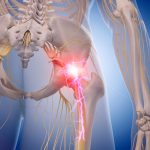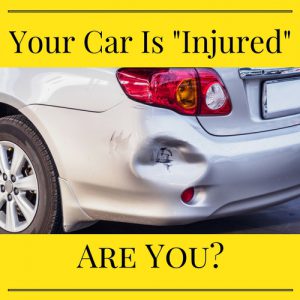 Even with little or no visible auto body damage, you may have an underlying bodily injury from your car accident.
Even with little or no visible auto body damage, you may have an underlying bodily injury from your car accident.
Following a collision, visual inspection of your car may only reveal a surface dent, but it may be accompanied by damage to the frame or undercarriage. Similarly, you may not realize the extent of your bodily injuries. After a motor vehicle accident, you may experience muscle stiffness or spasm, but you may not realize that your muscles may be reacting to a skeletal injury.
Don’t wait for pain to intensify before you see a doctor. Most motor vehicle insurance policies cover examination and treatment of injuries associated with car crashes with no out-of-pocket expenses for the patient. Failure to report your injuries to your insurance company before the prescribed deadlines could result in denial of your benefits. The doctor’s office staff will guide you through the process and help you protect your rights.
5 Vital Reasons to See a Doctor After a Car Accident:
(1) An exam by a musculoskeletal specialist can diagnose an underlying injury that may not present initially… (2) Timely documentation of your injuries are required by car insurance companies in order to receive payment for immediate and future medical expenses related to the accident… (3) Early diagnosis and natural treatment techniques can alleviate pain and reduce the need for risky pain medications… (4) Natural correction of mechanical alignment and management of scar tissue reduces the incidence of long-term chronic conditions, such as arthritis and chronic pain… (5) Effective treatment
will increase the likelihood of return to pre-accident levels of range of motion and proper joint function.
Why you should see a doctor that is a structural specialist after a motor vehicle accident — even if you don’t have pain.
When the body experiences the trauma of a car accident — whether a high-speed impact or a minor “fender bender” — the driver and occupants experience an adrenalin rush. The brain often secretes endorphins, dopamine, and other neural hormones that are natural painkillers. When these natural 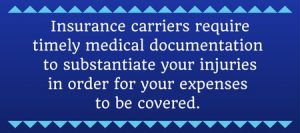 hormones block pain, auto accident victims “in shock” may have a false sense of “feeling fine.” This will dissuade many from seeking prompt medical attention.
hormones block pain, auto accident victims “in shock” may have a false sense of “feeling fine.” This will dissuade many from seeking prompt medical attention.
After a car crash, you bring your car to the auto body specialist, so you can get a complete evaluation of the damage. At first glance, you may think that there is only a small dent that needs to be “popped out.” But the auto body specialist looks for more extensive frame damage behind the bumper; sometimes they find more damage than expected from the minimal surface damage. It’s important to repair a bent frame on your car so that you don’t have more serious problems in the future. Most would agree that it is equally important to determine if your own body has sustained mechanical problems as a result of your car accident.
If your car requires an auto body specialist — doesn’t your body require a human body specialist?
Even if you are not currently experiencing pain, a proper exam by a musculoskeletal specialist after a car accident will determine if there is any hidden skeletal damage, such as soft tissue injuries or misalignments. Soft tissue injuries and skeletal misalignments, such as whiplash and other strain/sprain conditions are mechanical injuries commonly seen in automobile accident victims.
You may not even realize that you have a soft tissue injury or misalignment. Surprisingly, many studies have concluded that head and neck injuries can be substantial in low-speed impact collisions.¹ This points to the fact that the head and neck experience more g-forces than the car in these seemingly minor accidents.² ³ It is not unusual for accident victims to suffer lower back pain as well.
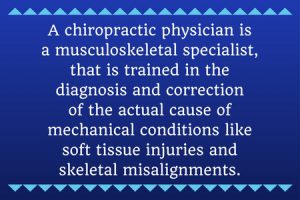 Most people feel that the stiffness and spasm they experience following a car crash will ”go away” on its own. Often over-the-counter or prescription pain medications will help, but do they? More often than not, mechanical problems require mechanical solutions. Treating accutane isotretinoin best price with NSAID’s like Advil or Aleve, prescription opioids or steroids will reduce the pain and inflammation from the initial trauma and will mask the pain from damaged or misaligned joints. Masking pain with drugs allows you to add insult to injury, interfering with healing, complicating matters further. If pain or discomfort persists days or weeks later, it may be from:
Most people feel that the stiffness and spasm they experience following a car crash will ”go away” on its own. Often over-the-counter or prescription pain medications will help, but do they? More often than not, mechanical problems require mechanical solutions. Treating accutane isotretinoin best price with NSAID’s like Advil or Aleve, prescription opioids or steroids will reduce the pain and inflammation from the initial trauma and will mask the pain from damaged or misaligned joints. Masking pain with drugs allows you to add insult to injury, interfering with healing, complicating matters further. If pain or discomfort persists days or weeks later, it may be from:
- misalignment not resolving;
- the accumulation of further insults to the injuries;
- or both.
Additional insults to the damaged tissues lengthens recuperation time and increases the likelihood of chronic pain and disability.
An exam by the structural specialist within the first week after your auto accident is recommended to properly diagnose and document your injuries.
Early intervention will reduce recovery time and the possibility of complications. Insurance carriers require timely medical documentation to substantiate your injuries in order for your expenses to be covered.
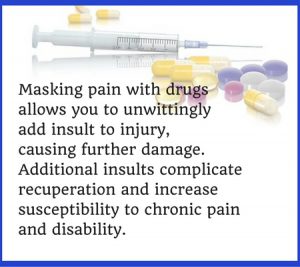
A chiropractic physician is a university trained doctor and musculoskeletal specialist, that completes a hospital based internship and residency where they gain proficiency in the diagnosis and correction of the actual cause of mechanical conditions like soft tissue injuries and skeletal misalignments. Doctors of chiropractic employ natural methods that gently adjust alignment and mobilize the affected areas, without risking the complications associated with opioid medications (which have serious side effects along with addiction potential).
Soft tissue injuries DO NOT always cause immediate pain. It’s not uncommon for pain to delay for days or even weeks after an auto collision. When left unaddressed, soft tissue injuries and skeletal misalignments are the type of injuries that can lead to chronic pain and post-traumatic arthritis. That’s why it’s best to make the mechanical corrections to your skeleton and connective tissues earlier rather than later. Early intervention deters future pain and progression of functional loss. If you heal misaligned or develop rigid scar tissue, the joint dysfunction may only be an annoyance now, but that is a warning signal. Left untreated joint destabilization often leads to complications as we age.
To understand the treatment for injuries from motor vehicle accidents, it helps to understand the nature of the damage and the underlying cause.
In car accidents, rapid acceleration then deceleration of the occupants can cause tearing or damage to the muscles, ligaments, joints and discs. This is referred to as strain/sprain, which is considered a soft tissue/connective tissue injury. Strain sprain is often accompanied by skeletal misalignment. See green vs red lines in diagram.
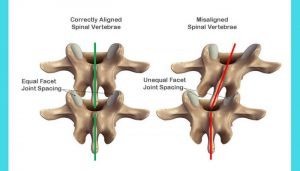
The facet joints in the above diagram (the white surface between the vertebrae) are the interlocking mechanism that allow for movement and flexibility of the spine. Like all joints, they are surrounded by ligaments, called capsular ligaments. Tears in the capsular ligament are caused by the forces transmitted in a crash. Pain results from the trauma, accompanied by reflexive /protective spasm. Restriction of a damaged joint is the body’s instinctive response to prevent further insult during the healing process.
When the ligament is torn, microhemmorhage (bleeding) occurs in the tears, resulting in scab formation with swelling. Scabs and swelling “cement” or “glue” the damaged parts together while they heal. Even when pain is absent, a feeling of tightness or spasm indicates muscle splinting. This is the body’s reaction to the bleeding and scabbing which is forming the scar tissue matrix of the ligament injury. The muscle splinting results in a restriction in movement that allows the parts to stay “clamped together” while they mend. Gentle guided movement by the chiropractor during the healing process allows the “glue” to stay flexible while healing.
However, muscle tension or spasm can also be a sign of misalignment, 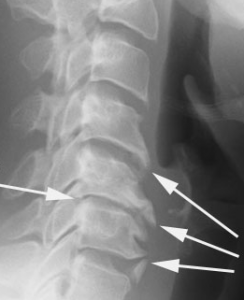 which is a major complication to the healing process. Misalignment impairs joint function by improperly shifting load points — overloading some joint surfaces. This often causes pain and interferes with restoration of normal neck movement. If you don’t have the acute misalignment diagnosed and properly realigned by a musculoskeletal specialist, the joints can heal in permanently misaligned position, as in an unset broken nose. Scar tissue that develops with misalignment becomes chronic — and may evolve into permanent arthritic joint changes. This is commonly seen as bone spurs and thinning or narrowing discs (see illustration). Spurs and thinning discs are often are a cause of pinched nerves.
which is a major complication to the healing process. Misalignment impairs joint function by improperly shifting load points — overloading some joint surfaces. This often causes pain and interferes with restoration of normal neck movement. If you don’t have the acute misalignment diagnosed and properly realigned by a musculoskeletal specialist, the joints can heal in permanently misaligned position, as in an unset broken nose. Scar tissue that develops with misalignment becomes chronic — and may evolve into permanent arthritic joint changes. This is commonly seen as bone spurs and thinning or narrowing discs (see illustration). Spurs and thinning discs are often are a cause of pinched nerves.
Another complication to healing occurs when pain is masked with drugs and the instinctive protective inhibition of movement is lost. Then unwitting additional insults to the injury can overload the joints, ligaments, and bones and cause an undesirable healing process. Overloading the joints with misalignment and/or overuse initiates a phenomenon that is explained in Wolff’s and Davis’ Law.
Wolff’s Law states that bone will adapt to the loads under which it is placed. If loading on a particular bone increases, the bone will remodel itself over time to become stronger to accommodate the additional loading. The bony matrix architecture
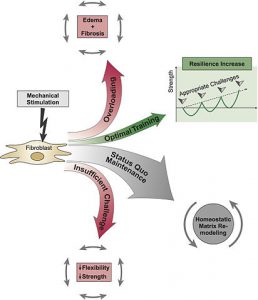 undergoes adaptive changes, becoming thicker as a result. The undesirable consequence of this natural development occurs after trauma and scar tissue heals with calcific cement to damaged structures. This calcific cement develops into spurs. Without proper management, spurs continue to grow and can eventually crowd the nerves and spinal cord, causing pain and disability. These are signs of arthritic progression, which fall under the diagnosis of spondylosis, spinal stenosis and bony ankyloses.4
undergoes adaptive changes, becoming thicker as a result. The undesirable consequence of this natural development occurs after trauma and scar tissue heals with calcific cement to damaged structures. This calcific cement develops into spurs. Without proper management, spurs continue to grow and can eventually crowd the nerves and spinal cord, causing pain and disability. These are signs of arthritic progression, which fall under the diagnosis of spondylosis, spinal stenosis and bony ankyloses.4
Davis’s Law describes how connective tissues re-model to imposed demands. It is the corollary to Wolff’s law (above). It is a physiological principle stating that soft tissues heal according to the manner in which they are mechanically stressed. As described above, connective tissue can also develop spur formation, disc thinning, and arthritic progression of spondylosis, spinal stenosis, and bony ankyloses. Again, spurs can cause spinal cord pressure and pinched nerves.4 (Illustration by www.fascialnet.com, Attribution, Link.)
Proper management of the scar tissue matrix and correction of misalignment during the healing phase optimizes the healing process with the goal of restoring the joint to normal function. If the skeleton remains misaligned or the damaged tissues are not correctly rehabilitated, the resulting scars are apt to form a rigid callous which can harden into a cement-like structure (spurs). Without proper management, spurs can pinch or stab neural tissue causing chronic pain and long-term disability.
Underlying skeletal issues require structural corrections for best short and long term treatment outcomes.
Chiropractic adjustment and manipulation gently mobilizes the “locked up” joints. Once flexibility is reestablished, the damaged joints heal with better function and less discomfort. Proper movement will soften the scab and mobility can return; however, if misalignment persists, the muscles remain tensed 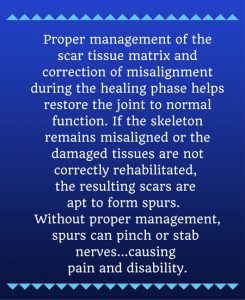 up in protective mode. When scar tissue heals joints in a misaligned position, not only is movement limited, but pain and arthritis commonly follows. Sometimes arthritis develops quickly…sometimes arthritis develops slowly and silently, the end point often will be natural fusion (known as ankylosis) versus surgical fusion.
up in protective mode. When scar tissue heals joints in a misaligned position, not only is movement limited, but pain and arthritis commonly follows. Sometimes arthritis develops quickly…sometimes arthritis develops slowly and silently, the end point often will be natural fusion (known as ankylosis) versus surgical fusion.
Chiropractors are clinically trained musculoskeletal specialists that will conduct a comprehensive physical examination focused upon the specific mechanism of injury affecting soft tissues, bones, joints and skeletal alignment.
Diagnosis of strain/sprain or disc injury is accomplished through a multi-faceted approach. The chiropractor will consult with you regarding your symptoms and the circumstances surrounding the accident, then perform an in-depth physical, structural, and neurological examination. When clinically indicated, the doctor may order specialized X-rays, MRI, CT scans and other diagnostic tests to identify soft tissue damage, skeletal misalignment, fractures, slipped discs, pinched nerves or other complications of motor vehicle injuries.
If underlying damage is diagnosed through examination, tests, and clinical evaluation, the chiropractor will address the underlying cause by employing specialized treatments. At Greenwich Kinetics, we utilize multiple therapeutic modalities for pain relief including cold laser, electric stimulation and manual therapy in conjunction with on-site massage therapy by our licensed massage therapists.
Rehabilitation of injury is accomplished through chiropractic adjustments and mobilization of joints affected by soft tissue damage. This manages the scar tissue matrix to be more flexible, reducing restriction of movement. Further rehabilitation is accomplished utilizing gentle chiropractic adjustments to correct skeletal misalignments.
We design an individualized exercise routine to stabilize the healing tissues and maintain normal movement. We routinely refer our patients to local physical therapists, whom we team closely with to supervise your rehabilitation. Restoring the joints and skeleton to their proper alignment will reduce the risk of chronic pain and disability associated with joint deterioration and progressive arthritic complications.
Early intervention by the musculoskeletal specialists at Greenwich Kinetics can prevent the complications of trauma from becoming overwhelming. Our experienced administrative staff are well versed in the submission process of motor vehicle accident claims and will help you secure benefits. We relieve you of the headaches of the insurance process, so you can focus on the care
you need, and let the doctor and massage/therapy team speed your recovery.
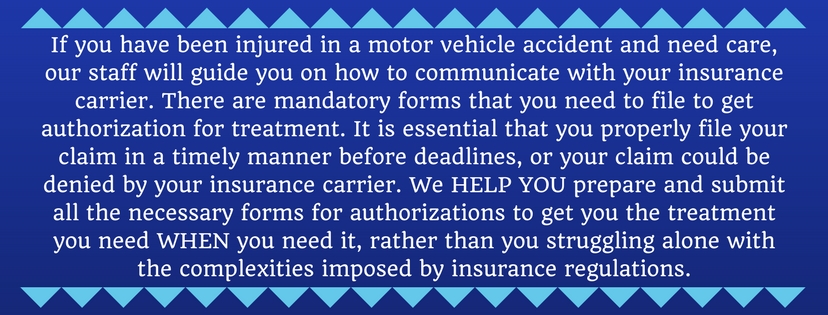
References
- Severy demonstrated conclusively that seemingly harmless low-speed rear-end collisions were capable of producing damaging forces to the head and neck. Severy and associates recorded head accelerations as great as 11.4 g. Most research evidence suggests that the major injuries are due to the hyperextension phase of the cervicothoracic spine. Severy DM, Mathewson JH, Bechtol CO. Controlled automobile rear- end collisions, an investigation of related engineering and medical phenomena. Can Serv Med J, 1995;11:727.
- Research quoted by White and Panjabe1 states that an eight mph rear-end collision may result in a 2 g-Force acceleration of the impacted vehicle and a 5 g-Force acceleration acting on the occupant’s head within 250 msec of impact. (One g- equals an acceleration of approximately 32 ft./sec.) Car crashes happen in literally one/two eye blinks. The point is that the head and neck experience more g-Forces than the car in low-speed impacts. White AA, Panjabi MM. Clinical Biomechanics of the Spine, New York, JB Lippencott, 1978, pp 153-158.
- Kenna and Murtaghsay state: “It is wrong to assume that maximum neck injury occurs in a high-speed collision; it is the slow or moderate collision that causes maximum hyperextension of the cervical spine. High-speed collisions often break the back of the seat, thus minimizing the force of hyperextension.” Kenna C, Murtagh J. Whiplash, Australian Family Physician, June, 1987; 16:6.
- From Wikipedia, the free encyclopedia. Text is available under the Creative Commons Attribution-ShareAlike License; additional terms may apply.
